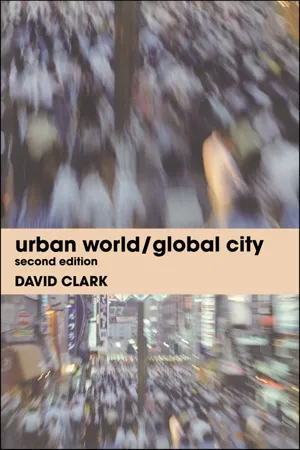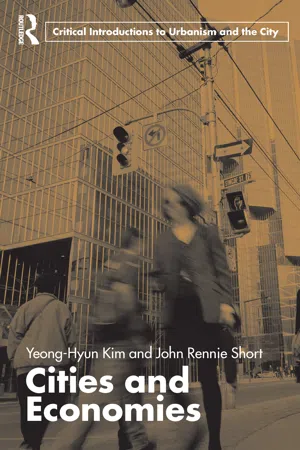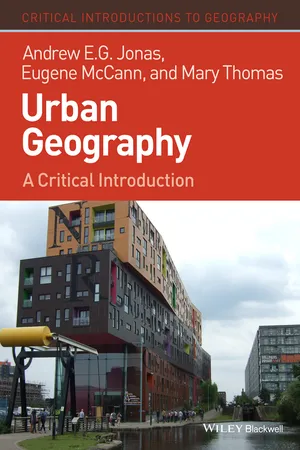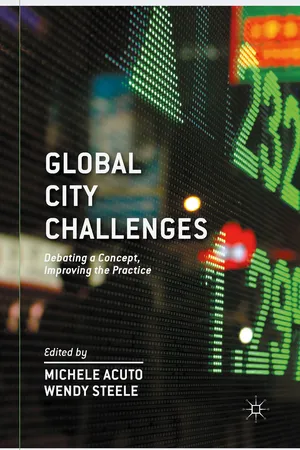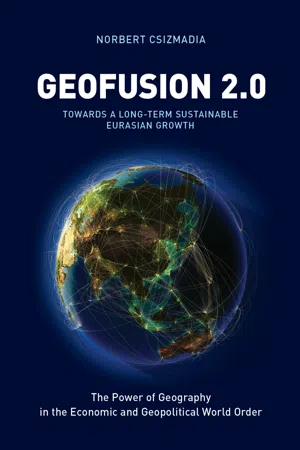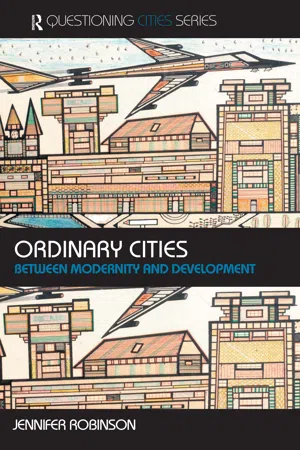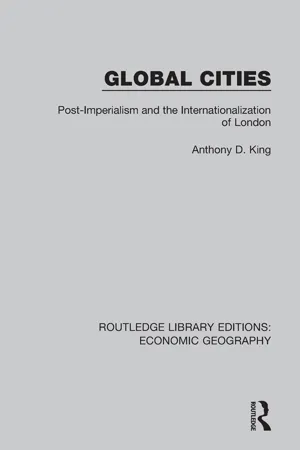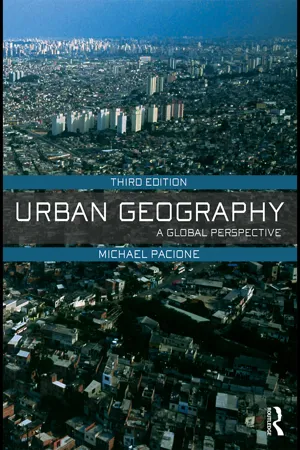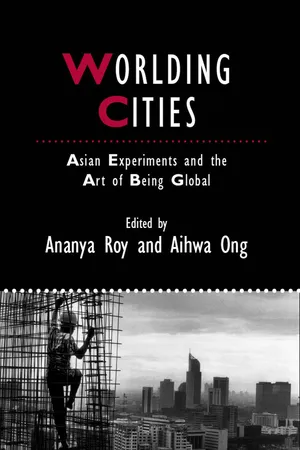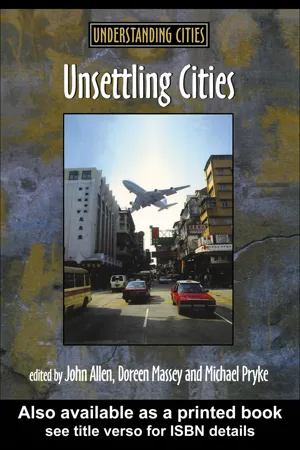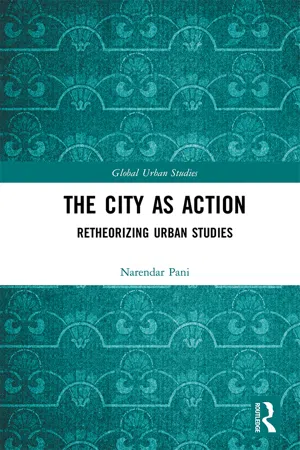Geography
World Cities
World cities are major urban centers that play a significant role in the global economy and culture. They are characterized by their large populations, diverse demographics, and influence on international affairs. These cities serve as hubs for finance, commerce, innovation, and communication, and often exhibit distinct characteristics such as high population density, advanced infrastructure, and global connectivity.
Written by Perlego with AI-assistance
Related key terms
Related key terms
1 of 4
Related key terms
1 of 3
11 Key excerpts on "World Cities"
- eBook - ePub
- David Clark(Author)
- 2004(Publication Date)
- Routledge(Publisher)
7 World Cities By the end of this chapter you should: understand the concept of World Cities and the debates which surround the meaning and significance of the term; be familiar with the functions of World Cities and the roles they play in the world economy; be aware of the issues which surround the specification and measurement of world city status; understand the reasons for the rise of World Cities. Introduction The urban world is dominated by a small number of centres that are the command and control points for global capitalism, the world’s dominant economic system. Such centres are distinguished not by their size or their status as capital cities of large countries, but by the range and extent of their economic power. They are the locations for the key individuals, institutions and organisations that manage, manipulate, dictate and determine the formation and reproduction of capitalism across the world. These attributes give such cities a disproportionate and exceptional importance, so that they occupy dominant positions in the global urban hierarchy. So pre-eminent is their status and so powerful and pervasive are their influences that many analysts argue that they merit designation as World Cities. Global economic importance and connectivity are the key criteria for world city status. Most observers today, taking their lead from the ideas of Friedmann (1986), see World Cities as the decision-making and control points for the world economy (Beaverstock et al., 1999). World Cities are distinguished by their roles as sites for the accumulation and concentration of capital and as places from which its distribution and circulation are organised and managed. They are favoured locations for the institutions of international production and consumption and the individuals and agencies that support and facilitate these activities. Function rather than size is critical - eBook - ePub
- Yeong-Hyun Kim, John Rennie Short(Authors)
- 2007(Publication Date)
- Routledge(Publisher)
The interface between globalization and urbanization pervades contemporary urban studies. External factors have long affected cities, yet the geographical scale of causes, processes and outcomes of urban changes has grown increasingly transnational, especially in recent decades. The fact that so many large cities, despite their distinctive histories and socio-political systems, are experiencing similar economic, cultural and spatial changes lies at the heart of so-called “globalization–urbanization nexus” literature. In many of these studies, globalization is interpreted not only as a major source of urban change but as a process that is itself facilitated by these changes.The impact of globalization has been observed in various urban sites around the world, yet the limited number of so-called World Cities or global cities – namely London, New York and Tokyo, and, to a lesser degree, Los Angeles and Paris – have received the majority of academic scrutiny. World Cities are those that function as primary hubs for global networks of business firms, financial institutions, (non-)governmental organizations and migrants – the “central places where the work of globalization gets done,” according to Sassen (2002: 8). Some argue that globalization simultaneously causes and reflects changes in the economies, cultures, politics and geographies of World Cities. This idea reinforces the role of World Cities – not nation states – as basic units of analysis for globalization. Taylor (2004) even promotes a shift from the state-centric to the city-centric view of the world for a deeper understanding of globalization and the unfolding world system.In this chapter, we review the existing studies of World Cities to assess what has been, or has not been, agreed on the list of World Cities and their particular role in globalization. The first section reviews world-cities research in urban studies, which dates back to the early twentieth century. In the second section, we look at the leading World Cities that seem to command the current world economy most effectively. The third and final section critically examines the data sources and analytic methods used to draw the global hierarchy of World Cities. - eBook - ePub
Urban Geography
A Critical Introduction
- Andrew E. G. Jonas, Eugene McCann, Mary Thomas(Authors)
- 2015(Publication Date)
- Wiley-Blackwell(Publisher)
Alternatively, cities associated with oppositional struggle, such as Seattle, Cairo, or the many “Occupy cities” might be foremost in our minds (Chapter 2). These are all perfectly valid metrics around which to construct a definition of global influence. Each addresses a certain form of significance and, once the categorization is agreed upon, research and analysis focuses on refining methods and definitions (How exactly do we measure what a city is demographically, for example?) and on assessing these cities’ role in the world. Nonetheless, for the majority of urbanists, the term “global cities” refers to a specific way of thinking about urban globalness – one associated with an extensive body of work conducted by geographers, sociologists, planners, and others that has come to be known as the “global cities literature.” This literature does not exemplify the only approach to understanding the relationships between cities and global processes, but it has been very influential and very useful. Therefore, it is a good starting point for a wider discussion of the variety of ways in which critical urbanists analyze urban globalness. Global cities literature. A literature in geography and urban studies that emerged in the 1980s around the term “World Cities” before adopting the term “global cities” in the 1990s. Still, the terms are used in combination and sometimes interchangeably. The literature is focused on understanding the ways in which cities are related to the organization of the contemporary global economy - eBook - ePub
Global City Challenges
Debating a Concept, Improving the Practice
- M. Acuto, W. Steele(Authors)
- 2013(Publication Date)
- Palgrave Macmillan(Publisher)
While we will see in closer detail in the next two chapters how this has been the case, it is crucial to understand here two key features. The increasing interest in the ‘global city’ has, firstly, promoted scholarly divergences and cross-disciplinary translations while, secondly, it has at the same time trickled into the practices and rhetoric that uphold urbanist practices, not only academia, in these very cities. The contested identity, and emerging pull, of the ‘global city’ Popularity rarely translates into universal definitional convergence, and ‘global city’ is no exception to this. As with several other popular terms in urban studies and geography, like ‘scale’ or ‘space’, there persists a vast variety of interpretations of what the ‘global’ city might be. Early urban studies such as those of Hall (1966) put a mostly qualitative emphasis on how these cities represent places where most of the regional and international business is conducted. This was progressively developed into a (mostly quantitative) discussion of the networked interconnection of major centres via Friedmann’s research hypothesis (Friedmann and Wolff, 1982) as well as Peter Taylor (2004b) and GaWC’s key role in formalizing the analysis of the ‘world city network’ of commerce, services and mobility that connects metropolises worldwide. At the same time, Sassen (1991) advocated how the focus on the ‘global’ city as a hub of command and control functions of those advanced producer services that are core to the neoliberal economy needed a conjunct analysis of how this economic order was shaping the social order of these cities. While many focused on how ‘global’ or ‘world’ cities (a definitional discrepancy discussed here in Chapters 2 and 3) are pivotal elements of contemporary world affairs, empirical and methodological divergences progressively developed into a variety of sub-disciplinary stances - eBook - ePub
Geofusion 2.0
The Power of Geography in the Economic and Geopolitical World Order
- Norbert Csizmadia, Bence Gáspár(Authors)
- 2021(Publication Date)
- PublishDrive(Publisher)
International Middleweights is a highly diverse group, including major cities from Canada, Europe, Asia, and Australia. The average population in the 26 metro areas is close to 5 million, and they have a complex economy. They include corporate and financial service centers among them that serve their whole country or region (e.g. Toronto, Sydney, Frankfurt, Madrid, Copenhagen) as well as industrial centers (Fukuoka, Nagoya, Stuttgart, Karlsruhe, Milan, Barcelona). They increasingly specialize in knowledge-intensive sectors and modern production technologies, or a combination of these.Figure 75: New classification of global cities Source: Brookings Institute, 2016 New global urban competitiveness – “Fusionopolis”When it comes to urban development in the 21st century, several city types can be distinguished. There are green cities with a vertical concept; flexible cities that are economical and also mindful of the natural environment; walkable cities; cultural hubs; and aeropolises, which are a recent phenomenon, referring to cities built around a global aerial hub. In the next 15 years, the center of gravity of the world’s cities will shift to the south and even more to the east. Nowadays, the metropolitan areas of advanced regions are undoubtedly economic giants. In the 21st century, cities are the main arteries and target areas of economic life. In the age of fusions and networks, cities and their roles become even more important. Livability, diversity, cultural features, international connectivity, their status in the financial scene (Figure 76), and scientific life (start-up cities and smart cities with world-leading universities) determine new functions. By combining the new functions, new fusions are born. I have coined, these new global cities as “Fusionopolises” (Csizmadia, N. 2018).Figure 76: Global financial centers, 2016 Source: Csizmadia, N., Geopillanat (Geofusion) (2016), based on the map of Mathenson, Zara pp. 306-307.Cities’ ranking in the global competition is determined by increasingly complex analyses, taking into account not only economic development but also alternative environmental and social data. Cities’ position in livability rankings is often a separate factor in multinational corporations’ decisions when choosing a place for their branches or headquarters or formulating their geostrategy and the directions of their geographic expansion. Building on the existing competitiveness indices, the results were synthetized during research to create a global urban competitiveness ranking, which produced new findings when all the factors were taken into account. The following factors are increasingly crucial in cities’ competitiveness: population size, economic indicators, technological, financial, and cultural status, accessibility, integration into the global economy, and infrastructure, as well as the new indicators, such as the size of green areas, the number of digital nomad jobs, sustainable urban transportation, family- and child-friendliness, the role of culture, the number of start-ups, the relationship between universities and new high-tech firms, sport opportunities, livability, and sustainability requirements (Csizmadia, N. 2018). - eBook - ePub
Ordinary Cities
Between Modernity and Development
- Jennifer Robinson(Author)
- 2013(Publication Date)
- Routledge(Publisher)
It is the overlapping networks of interaction within the city – networks that stretch beyond the physical form of the city and place it within a range of connections to other places in the world – which, for Amin and Graham (1997), are a source of potential dynamism and change. The range of potential international or transnational connections is substantial: cultural, political, urban design, urban planning, informal trading, religious influences, financial, institutional, intergovernmental and so on (Smith 2001). To the extent that it is a form of economic reductionism (and reductionism to only a small segment of economic activity) that sustains the regulating fiction of the global city, this spatialised account of the multiple webs of social relations that produce ordinary cities could help to displace some of the hierarchising and excluding effects of this approach. For with so many different processes shaping cities and so many potential interactions amongst them, it would be difficult to decide against which criteria to raise a judgement about rank.Categorising cities and carving up the realm of urban studies has had substantial effects on how cities around the world are understood and has played a role in limiting the scope of imagination about possible futures for cities. This is as true for cities declared ‘global’ as for those that have fallen off the map of urban studies. The global-cities hypothesis has described cities such as New York and London as ‘dual cities’, with the global functions drawing in not only a highly professional and well-paid skilled labour force, but also relying on an unskilled, very poorly paid and often immigrant workforce to service the global companies (Sassen 1991, Allen and Henry 1995). These two extremes by no means capture the range of employment opportunities or social circumstances in these cities (Fainstein et al. 1992, Buck et al. 2002). It is possible that these cities, allegedly at the top of the global hierarchy, could also benefit from being imagined as ‘ordinary’. The multiplicity of economic, social and cultural networks that make up these cities could then be drawn on to imagine possible paths to improving living conditions and enhancing economic growth across the whole city. - eBook - ePub
- Anthony King(Author)
- 2015(Publication Date)
- Routledge(Publisher)
Such cities ‘as the places where this politico-economic specialization is grounded physically, are the cotterpins holding the capitalist world economic system together’ (Feagin, 1985: 30). Cities such as these are seen to be at the apex of a new hierarchy of World Cities that Cohen’s definitive paper (1981) identified as emerging in the early 1970s. As multinational production and international finance became more dominant in Europe and Asia, an earlier hierarchy of national centres (see earlier editions of Hall, 1984) began to be displaced by a new hierarchy, characterized by corporate headquarters of multinational headquarters and banks. THE RISE OF World Cities: ALTERNATIVE ACCOUNTS The massive increase in the internationalization of capital (or rather, of capitalist relations of production) over the last two decades is the common explanatory factor in all accounts of the world-city phenomenon (Cohen, 1981; Feagin and Smith, 1987; Friedmann and Wolff, 1982; Ross and Trachte, 1983; Sassen-Koob, 1984; 1986; Thrift, 1986b). The detailed study of restructuring in Los Angeles by Soja et al. (1983) provides the most comprehensive theoretical account of what they term the ‘global capitalist city’. Both here and elsewhere, Soja (1986) draws on Mandel’s (1978) arguments on long wave restructuring: at different historical periods, major and minor restructurings of capital have taken place, which have had different effects at different levels of the world economy (e.g. national, subnational, and city). In the last two decades, a much more dramatic internationalization of capital has taken place, leading to a more widely distributed system of production: the degree and extent of this change was most obviously manifest in the 1980 census figures and this prompted some of the earlier research (Soja, personal communication, 1987) - eBook - ePub
Urban Geography
A Global Perspective
- Michael Pacione(Author)
- 2009(Publication Date)
- Routledge(Publisher)
city has an individual character, urban places also exhibit common features that vary only in degree of incidence or importance within the particular urban fabric. All cities contain areas of residential space, transportation lines, economic activities, service infrastructure, commercial areas and public buildings. In different world regions the historical process of urban evolution may have followed a similar trajectory. Increasingly, similar processes, such as those of suburbanisation, gentrification and socio-spatial segregation, are operating within cities in the developed world, in former communist states and in countries of the Third World to effect a degree of convergence in the nature of urban landscapes. Cities also exhibit common problems to varying degrees, including inadequate housing, economic decline, poverty, ill health, social polarisation, traffic congestion and environmental pollution. In brief, many characteristics and concerns are shared by urban places. These shared characteristics and concerns represent the foundations for the study of urban geography. Most fundamentally, the character of urban environments throughout the world is the outcome of interactions among a host of environmental, economic, technological, social, demographic, cultural and political forces operating at a variety of geographic scales ranging from the global to the local.In this book we approach the study of urban geography from a global perspective. This acknowledges the importance of macro-scale structural factors in urban development, but also recognises the reciprocal relationship between global forces and locally contingent factors in creating and recreating the geography of towns and cities. A global perspective also demonstrates the interdependence of urban places in the contemporary world, and facilitates comparative urban analysis by revealing common and contrasting features of cities in different cultural regions. This global perspective resonates with recent transnational1 and postcolonial 2 approaches to urban study. The global perspective eschews the analytical value of simplistic distinctions between cities based on, for example, level of development; rejects prioritisation of knowledge produced in one world region or city over another; and seeks to understand cities by drawing on the richness and diversity of urban experience that characterises our contemporary urban world.While the organisation of this book into sections and chapters is a necessary pedagogic device to bring order to the complex and diverse subject matter of urban geography, the global perspective underlines the interconnections among the different sections, chapters and themes presented. In addition, the global perspective not only promotes integrated insight into our urban world but also encourages readers to ‘think outside the box’ and seek to relate experiences across different urban and cultural realms. - eBook - ePub
Worlding Cities
Asian Experiments and the Art of Being Global
- Ananya Roy, Aihwa Ong(Authors)
- 2011(Publication Date)
- Wiley-Blackwell(Publisher)
It is therefore not surprising to observe that there is no singular or fixed standard of urban globality; there are many forms of “the global” in play. The very contested nature of what counts as global in a shifting inter-urban field of power requires urban analysis to capture the reflexive dimension in many urban initiatives that go beyond local improvements to participate, however implicitly, in a bigger game of winning some kind of world recognition. Today, residents of Asian cities large and small like to think of their hometown as having some degree of global significance, or having attained some level of “world-class” standing. Indeed, as we shall see in the chapters that follow, major urban projects are invariably caught up in an inter-city competition over the “global” stature of hometowns.Furthermore, in this emerging region, the tendency is no longer simply to turn to Western prototypes, but rather to develop from homegrown solutions to Asian metropolitan challenges, distinctive urban profiles, political styles, and aesthetic forms. Urban initiatives of all kinds are thus experiments with metropolitan futures, and they draw on disparate styles, actors, and forms that circulate in and through Asian metropolitan centers. In sum, worlding practices are constitutive, spatializing, and signifying gestures that variously conjure up worlds beyond current conditions of urban living. They articulate disparate elements from near and far; and symbolically re-situate the city in the world. By eschewing singular concepts of worlding, single standards of urban ranking that take for granted the terms in and through which cities can be ranked, and unified ways of achieving an already given future, we open up academic inquiries into a diversity of urban activities engaged in the transformation of contemporary urban living. In urban Asia, we encounter an art of being global that is invariably caught up in a political game that is allusive, contrastive, comparative, and contested, with cities in the region, but also beyond.Modeling, Inter-Referencing, New SolidaritiesDrawing on new research presented in the chapters, we identify three styles of being global that, while not exclusive to Asia, seem to be distinctive practices associated with urban development in the region. Worldwide, aspirant cities vie with one another in to leave some mark on the world stage. Different attempts to burnish city images, shape skylines, or push through innovative urban agendas can be found in many domains and scales of renovation. Besides mega-projects supported by politicians, planners, and boosters, there are also a variety of political, cultural, and economic projects pursued by activists, migrants, and artists to improve the condition and standing of their hometowns vis-à-vis others that are experienced as being in de facto - eBook - ePub
Unsettling Cities
Movement/Settlement
- John Allen, Doreen Massey, Michael Pryke(Authors)
- 2005(Publication Date)
- Routledge(Publisher)
Sassen, S. (1995) ‘On concentration and centrality in the global city’ in Knox, P.L. and Taylor, P.J. (eds).- Storper, M. and Salais, R. (1997) Worlds of Production: The Action Frameworks of the Economy , Cambridge, MA, Harvard University Press.
- Skeldon, R. (1997) ‘Hong Kong: colonial city to global city to provincial city?’, Cities , vol. 14, no.5, pp. 265–271.
- Taylor, P.J. (1997) ‘Hierarchical tendencies amongst World Cities: a global research proposal’, Cities , vol.14, no. 6, pp. 323–332.
READING 5A: Saskia Sassen: ‘On concentration and centrality in the global city'
At the global level, a key dynamic explaining the place of major cities in the world economy is that they concentrate the infrastructure and the servicing that produce a capability for global control. The latter is essential if geographic dispersal of economic activity—whether factories, offices, or financial markets—is to take place under continued concentration of ownership and profit appropriation. This capability for global control cannot simply be subsumed under the structural aspects of the globalization of economic activity. It needs to be produced. It is insufficient to posit, or take for granted, the awesome power of large corporations.By focusing on the production of this capability we add a neglected dimension to the familiar issue of the power of large corporations. The emphasis shifts to the practice of global control: the work of producing and reproducing the organization and management of a global production system and a global marketplace for finance, both under conditions of economic concentration. Power is essential in the organization of the world economy, but so is production: including the production of those inputs that constitute the capability for global control and the infrastructure of jobs involved in this production. This allows us to focus on cities and on the urban social order associated with these activities.Much analysis and general commentary on the global economy and the new growth sectors does not incorporate these multiple dimensions. Elsewhere I have argued that what we could think of as the dominant narrative or mainstream account of economic globalization is a narrative of eviction (Sassen, 1993 , 1994a - eBook - ePub
The City as Action
Retheorizing Urban Studies
- Narendar Pani(Author)
- 2022(Publication Date)
- Routledge(Publisher)
2009 ).The distinction between the urban process and the places of the city is also reflected in the seemingly contradictory experiences of the global and the local. A focus on actions makes it clear that the global and the local may, in many ways, represent two different worlds, but in terms of what a person does, the two worlds not only coexist, but could also feed off each other. The people of a city are often a part of global processes even as they remain rooted in the local of everyday life. The processes of agglomeration that bring them to a city can be the result of global circuits. These circuits, and the agglomerations they generate, have the potential to link the most remote of villages to global brands. Workers can be drawn from remote parts of a country to work in the construction of campuses in cities of the global South, to house the technical manpower serving global information technology brands. Yet the workers constructing those campuses are likely to know very little about the global brands that the technical manpower serves. Their concerns in the city are likely to be much more local, whether it is the congested sheds they live in or the food they have to make do with. The participation of the individual worker in the city in both the global and the local domains would throw up a dilemma of whether we should treat the workers and, by extension the cities they are a part of, as a part of global or local processes. It is tempting to address this dilemma by beginning from one extreme or the other, say from the global of Planetary Urbanization to the local of Ordinary cities, and then find a way towards the middle. But once we move away from the clarity of the abstract extremes, how exactly do we determine when we are in the middle, and whether the middle is, in fact, where we should be. The middle may give the impression of academic balance, but does it tell us all that we want to know about the city? The method of actions finds a way out of this dilemma. By going beyond the individuals to their actions, it deals with both the global actions of an individual as well as her local actions. By treating the urban as the actions related to agglomeration and polarization, and their consequences, it recognises this as potentially a part of global processes. At the same time the actions related to the places of a city are local. The method of actions allows us to recognize the global in the urban even as we celebrate, and remember, all that is local in a city.
Index pages curate the most relevant extracts from our library of academic textbooks. They’ve been created using an in-house natural language model (NLM), each adding context and meaning to key research topics.
Explore more topic indexes
Explore more topic indexes
1 of 6
Explore more topic indexes
1 of 4
